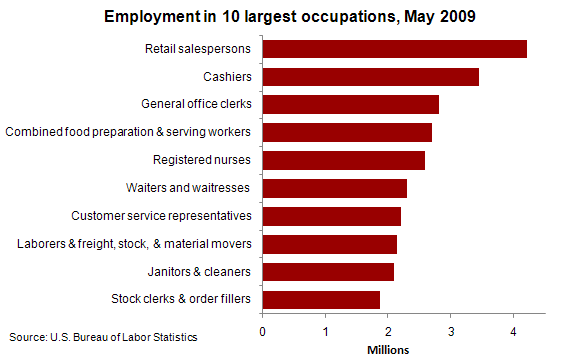05.19.10
State of labor - low paying jobs are becoming the norm
Via Reliable Plant, Employment and wages for the 10 largest occupations.
In May 2009, the 10 occupations with the highest employment levels represented more than 20 percent of total employment, and the number of workers in these occupations ranged from 1.9 million workers to 4.2 million workers.
Most of these occupations were relatively low paying: 9 of the 10 largest occupations had median wages between $8.28 per hour and $14.56 per hour. Median wages for all occupations in the United States were $15.95 per hour in May 2009. The one exception among the 10 largest occupations was registered nurses, whose median wages were $30.65 per hour. Employment among registered nurses was 2.6 million in May 2009.
This comes from a recent report from the Bureau of Labor Statistics, Occupational Employment And Wages –May 2009 [PDF], released last Friday. Unfortunately it looks like these types of low paying jobs will continue to be most prevalent in the future.
As the economy recovers and Americans get back to work, the wage gap between white- and blue-collar work is expected to grow. According to new data from the Bureau of Labor Statistics, 60 million people—46 percent of the American workforce—in 2009 worked in the service sector as cashiers, office clerks, cooks, nurses, retail salespeople, or customer-service representatives.
Here’s a common story for those who had to change jobs in the last decade. From a Newsweek article back in December 2009, The New Working Reality.
By the time Kelley Krostoski was laid off from her job as a management consultant this past February, she assumed that she’d be able to find another position closer to her Oregon home, perhaps even something that would not require her to travel.
Ten months later, her initial optimism has given way to resignation. She landed another gig in September as a consultant that required her to take an 11 percent wage cut. She still travels up to three months a year, though that’s better than the six months a year spent on the road at her previous job. Overall, Krostoski says she’s relieved. “There aren’t many jobs in Oregon,” she says, noting the state’s 11.3 percent unemployment rate. “I [know] folks who have been looking for a job for a year or more.”
In the current economy, many Americans have had to lower their expectations for their career and work lives. Like Krostoski, they’ve taken pay cuts to secure new jobs. They’ve postponed retirement to help struggling family members, and millions of Americans remain underemployed, working part-time or low-wage jobs to pay the bills. “There’s a reluctance to settle,” says Andrew Gledhill, an economist with Moody’s Economy.com. “In these once-in-a-generation types of recessions, you don’t have a choice.”
The story of someone losing a job, and having to replace it with one with a lower salary, has become all too familiar since the turn of the century. While there are many reasons for this one is certainly the fact that workers don’t have the education they need. Today the Texas Association of Business (TAB), whose main goal is to keep taxes low on businesses and corporations in Texas, released a new report.
The Texas Association of Business (TAB) today released a report entitled Dream Big Texas: Educating a Globally Competitive Workforce, detailing the improvements needed to maintain our state’s status as an international economic powerhouse.
“The Texas economy has been the beneficiary of extraordinary natural resources, fiscally conservative leadership and hardworking men and women who form the core of our workforce,” said TAB President Bill Hammond. “Yet for all our progress in building the best business climate in America, the threat Texas faces if we do not produce well-educated graduates who can fill increasingly sophisticated jobs, puts all that at risk.
While TAB is correct about the need for a well-educated workforce, they don’t mention the inherent dichotomy in what they state. The reason Texas has the “best business climate in America” - if that’s possible without a well-educated workforce - is because that climate is created by sustenance taxation of the wealthy, big business, and corporations which have starved education in this state. Ironic isn’t it? TAB also doesn’t offer much in the way of a solution other than using some sort of a performance based funding mechanism for funding post-secondary education.
With the decline of well-paying union manufacturing jobs in this country, it looks like these kinds of low-paying service jobs are what’s likely to take their place and become the norm. Unless we begin to take education seriously and are willing to pay for it. A well-educated population is the best investment for future economic development there is, and we must be willing to give it the necessary funding. The money will be paid back and then some by future economic growth.
